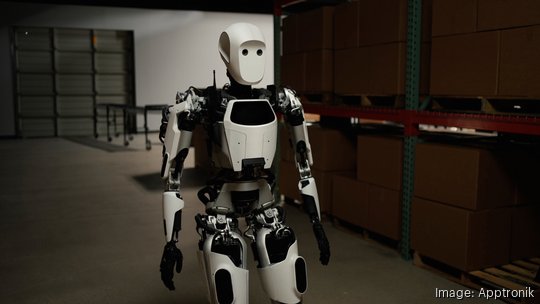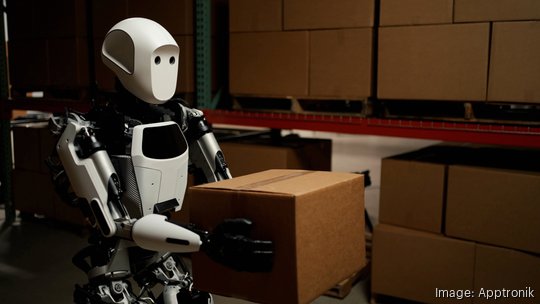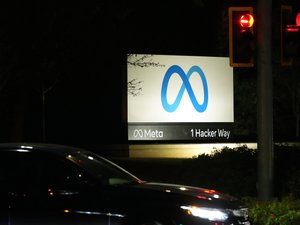
We're still a long way from having highly personable robots like the Johnny 5 that filmmakers envisioned in the the 1980s film "Short Circuit."
But we're getting closer.
Case-in-point: Apollo, a humanoid robot developed through a decade of iterations by Austin startup Apptronik. It's 5 foot 8 inches tall and weighs 160 pounds. It can lift up to 55 pounds, and its primary function so far is moving boxes around in warehouses.
But Apollo's just getting started, Apptronik co-founder and CEO Jeff Cardenas said. The robot, he said, is like an iPhone in that it will be able to have new applications loaded to give it new functions. And, as it learns from new data it gleans from being in new settings and getting new instructions, it is expected to perform more dexterous tasks in complex situations.
By now, many people have already seen robotic arms assembling cars or dog-like robots tromping through obstacle courses or even construction sites. What sets Apollo apart is its human-like form, which Apptronik said will allow it to work pretty much anywhere humans work. No need to confine it to customized environments.
"We've built 13 unique different types of robots," Cardenas said. "So eight iterations on humanoids. Some of those are just legs, upper torsos and many full humanoids. Then, two exoskeletons, powered exoskeletons, and then three different types of mobile robotic arms. But all of this was to solve all the pieces and the technology problems that were required to build Apollo. Apollo's kind of what we've been working towards since we started, and the robot we've always dreamed of building."
Another thing Cardenas said sets Apollo apart from the many other robots out there is that it will be available for mass manufacturing. While Apptronik has been building its initial models here in Austin, it's in conversations with manufacturers in Texas to build out many more Apollos as demand grows.
"Seeing is believing, and so it was important for us to show the robot really working and doing stuff when we launched," Cardenas said. "And we'll continue to show it off as we move ahead."
Cardenas said the company is uniquely situated to provide robots to the mass manufacturing and warehousing operations in northern Mexico and Texas. It plans to offer Apollo as a rentable service that will give warehousers a robotic option for roughly the same price as a human worker, and Cardenas notes that Apollo won't be bothered by the heat waves that have made work difficult for so many warehouse workers through a historically hot summer.
The bot has swappable batteries, each with a four-hour runtime, freeing it up from recharging downtime.
"Robotics solutions are in high demand in the logistics sector as companies grapple with a shortage of labor and volatile demand. Billions of dollars are being invested in implementing robots to help pick, move and sort goods through warehouses across the world," Ash Sharma, managing director at market intelligence firm Interact Analysis, stated. "Humanoid robotic solutions are the next step in the evolution of the industry as customers look for more flexible automation that can be used across multiple workflows."
Apptronik teamed up with Austin-based design firm Argodesign to develop Apollo's interfaces. The teams were careful not to make Apollo too much like a human, which tends to make us uncomfortable, a sensation sometimes referred to as the uncanny valley. Apollo has cameras for eyes, and its mouth can display text, smile or convey other information. The bot's chest, meanwhile, has a display that can provide information such as what task Apollo is working on, its progress on that task and what it plans to do next. Cardenas said the company plans to integrate voice communications, as well.
"That's kind of the beauty of a general purpose platform," he said. "It's a software update away from a new feature."
Apptronik also plans to sell Apollo and offer software updates to its owners. Cardenas didn't give an exact price, but said he expects it to be in line with the cost of a new car – or somewhere under $50,000. The company already has a signed purchase order, but most of its robots are currently being used in pilot projects, Cardenas said.

Apptronik has many competitors in the expanding field of robotics, including Tesla Inc., which in May demonstrated its bot Optimus' walking and picking up capabilities.
Apptronik has raised about $28 million in funding. It currently has 85 full-time employees, most of whom work at its office and development center in North Austin. The company plans to raise a series A round of funding in coming months, and it is currently hiring for several roles.
"In some of our job postings, we've had thousands of applicants," Cardenas said. "It's been exciting to see progress and develop."
While Apollo is the company's latest reveal, Apptronik continues to work with NASA and the University of Texas, as well as partners like argodesign.
"Over the next year, we're going to continue to refine it, continue to increase the performance of the system and dial it in before we really move to full commercial release, which will happen at the end of next year," he said. "So we still have a lot to learn. Think of this as the personal computer in the early 80s. This is the beginning of the next wave, and so there's there's still a long way to go, but it's exciting that we've even gotten to this point."








